Abstract
We developed a method for cAMP and cGMP immunocytology based upon fixation by microwave irradiation. Fixation by microwave irradiation prevented three problems found with other fixation methods: nucleotide loss from cells, nucleotide diffusion within cells, and chemical modification of immunologic epitopes. Six agonists (four that stimulate adenylate cyclase and two that stimulate guanylate cyclase) produced cAMP or cGMP accumulation patterns that were agonist-specific, dose-dependent, detectable at physiologic concentrations of hormone, and time-dependent within 15 sec to 30 min. cAMP accumulation after 1 mM forskolin was greatest in the nucleus. Isoproterenol, prostaglandin E2, or calcitonin caused initial accumulation of cAMP along the plasma membrane, but later accumulation was greater in the cytoplasm. With calcitonin the later accumulation of cAMP was selectively perinuclear and along the nuclear membrane. Sodium nitroprusside stimulated cGMP accumulation diffusely throughout the cytoplasm. Atrial natriuretic peptide initiated cGMP accumulation near the plasma membrane, and cGMP accumulation moved from there into the cytoplasm. In conclusion, microwave irradiation preserved cell structure and allowed visualization of expected as well as unsuspected changes in intracellular accumulation patterns of cAMP and cGMP.
Full text
PDF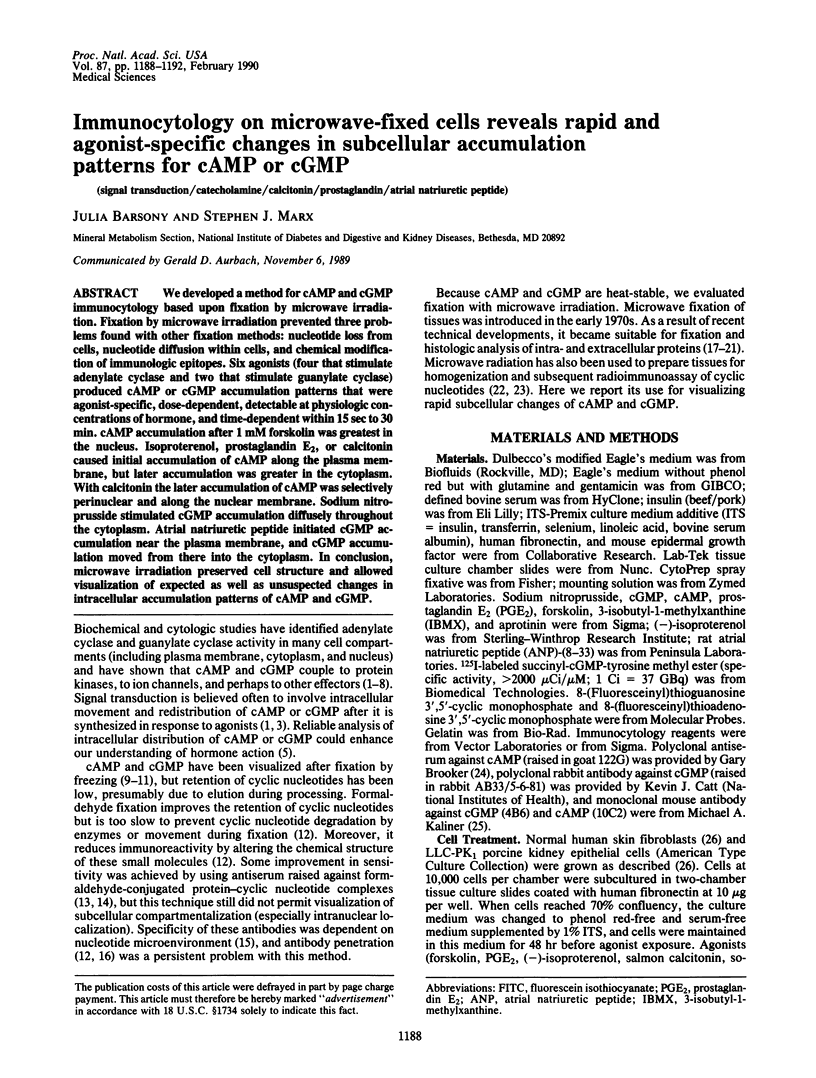
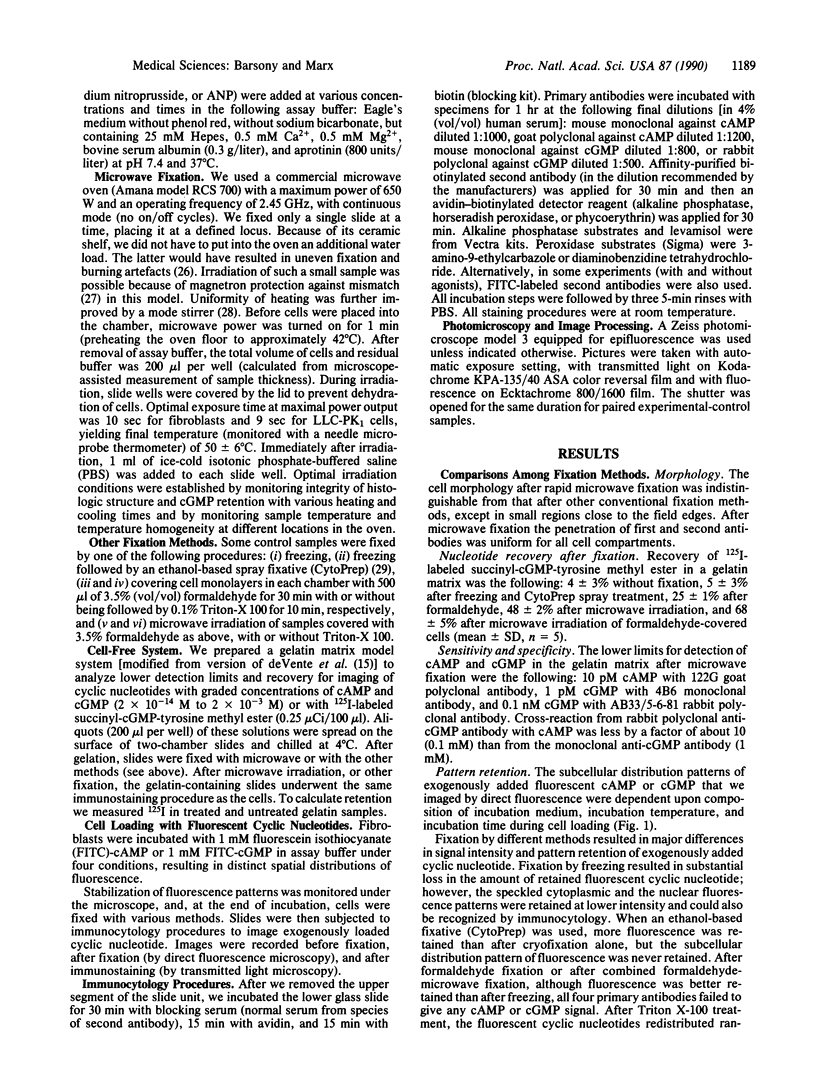
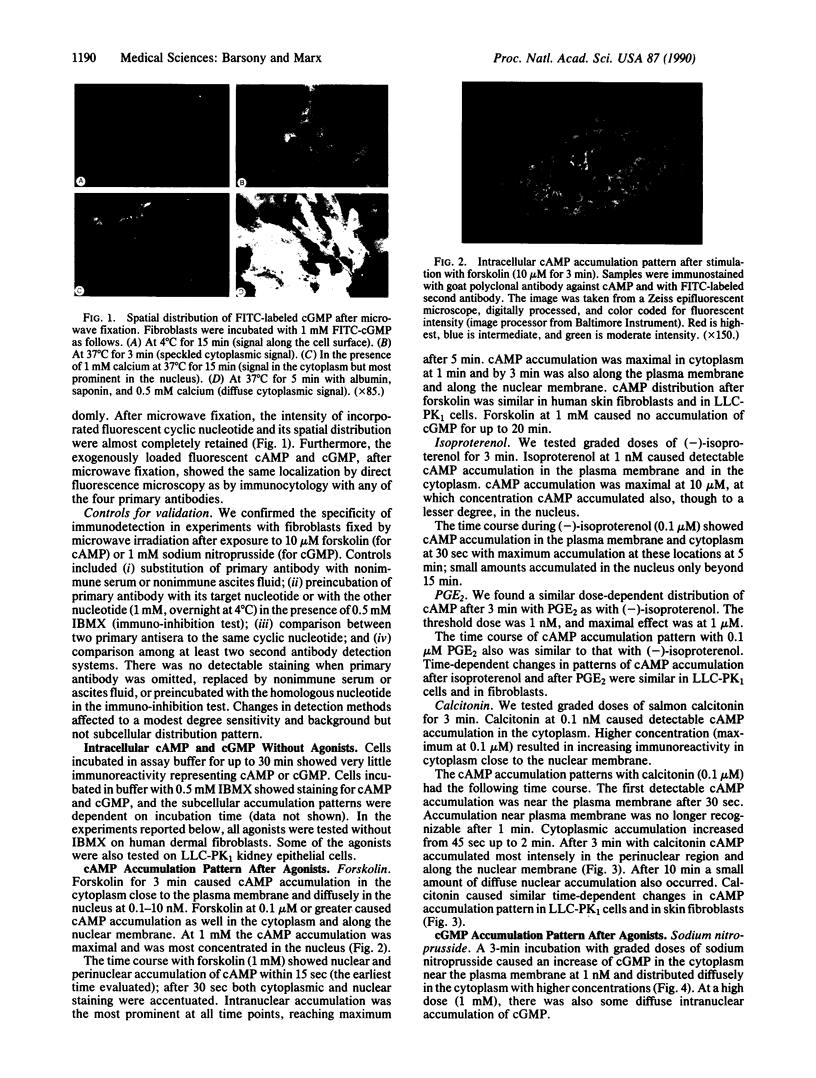
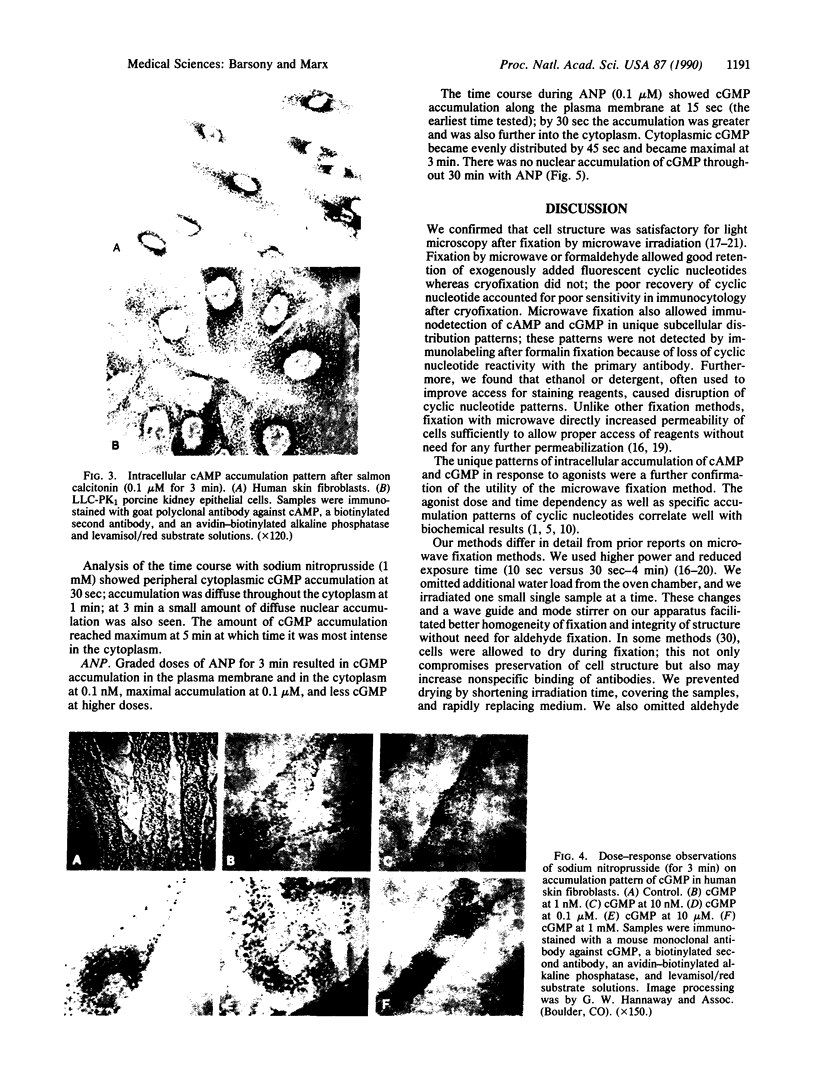
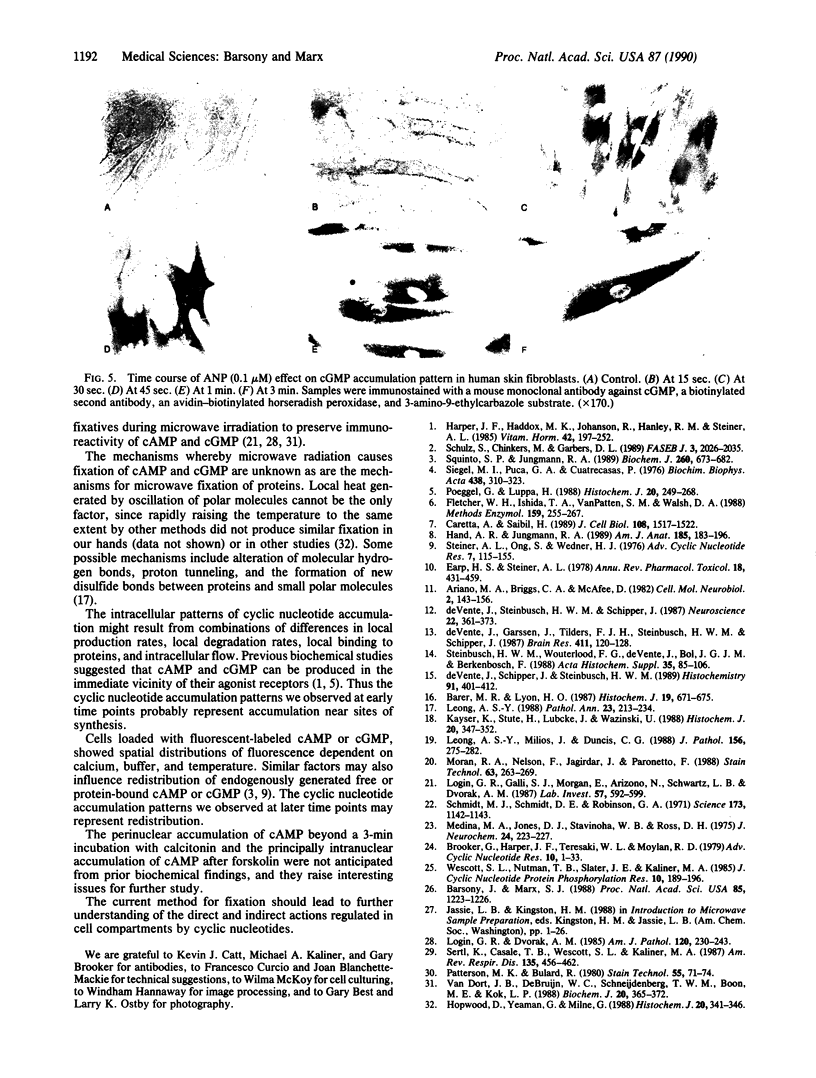
Images in this article
Selected References
These references are in PubMed. This may not be the complete list of references from this article.
- Barer M. R., Lyon H. O. The impact of different fixation procedures on staining of macromolecules in a microtiter system. Histochem J. 1987 Dec;19(12):671–675. doi: 10.1007/BF01676174. [DOI] [PubMed] [Google Scholar]
- Barsony J., Marx S. J. Receptor-mediated rapid action of 1 alpha,25-dihydroxycholecalciferol: increase of intracellular cGMP in human skin fibroblasts. Proc Natl Acad Sci U S A. 1988 Feb;85(4):1223–1226. doi: 10.1073/pnas.85.4.1223. [DOI] [PMC free article] [PubMed] [Google Scholar]
- Brooker G., Harper J. F., Terasaki W. L., Moylan R. D. Radioimmunoassay of cyclic AMP and cyclic GMP. Adv Cyclic Nucleotide Res. 1979;10:1–33. [PubMed] [Google Scholar]
- Caretta A., Saibil H. Visualization of cyclic nucleotide binding sites in the vertebrate retina by fluorescence microscopy. J Cell Biol. 1989 Apr;108(4):1517–1522. doi: 10.1083/jcb.108.4.1517. [DOI] [PMC free article] [PubMed] [Google Scholar]
- Earp H. S., Steiner A. L. Compartmentalization of cyclic nucleotide-mediated hormone action. Annu Rev Pharmacol Toxicol. 1978;18:431–459. doi: 10.1146/annurev.pa.18.040178.002243. [DOI] [PubMed] [Google Scholar]
- Fletcher W. H., Ishida T. A., Van Patten S. M., Walsh D. A. Direct cytochemical localization of regulatory subunit of cAMP-dependent protein kinase using fluoresceinated catalytic subunit. Methods Enzymol. 1988;159:255–267. doi: 10.1016/0076-6879(88)59026-2. [DOI] [PubMed] [Google Scholar]
- Hand A. R., Jungmann R. A. Localization of cellular regulatory proteins using postembedding immunogold labeling. Am J Anat. 1989 Jun-Jul;185(2-3):183–196. doi: 10.1002/aja.1001850211. [DOI] [PubMed] [Google Scholar]
- Harper J. F., Haddox M. K., Johanson R. A., Hanley R. M., Steiner A. L. Compartmentation of second messenger action: immunocytochemical and biochemical evidence. Vitam Horm. 1985;42:197–252. doi: 10.1016/s0083-6729(08)60063-1. [DOI] [PubMed] [Google Scholar]
- Hopwood D., Yeaman G., Milne G. Differentiating the effects of microwave and heat on tissue proteins and their crosslinking by formaldehyde. Histochem J. 1988 Jun-Jul;20(6-7):341–346. doi: 10.1007/BF01002727. [DOI] [PubMed] [Google Scholar]
- Kayser K., Stute H., Lübcke J., Wazinski U. Rapid microwave fixation--a comparative morphometric study. Histochem J. 1988 Jun-Jul;20(6-7):347–352. doi: 10.1007/BF01002728. [DOI] [PubMed] [Google Scholar]
- Leong A. S. Microwave irradiation in histopathology. Pathol Annu. 1988;23(Pt 2):213–234. [PubMed] [Google Scholar]
- Leong A. S., Milios J., Duncis C. G. Antigen preservation in microwave-irradiated tissues: a comparison with formaldehyde fixation. J Pathol. 1988 Dec;156(4):275–282. doi: 10.1002/path.1711560402. [DOI] [PubMed] [Google Scholar]
- Login G. R., Dvorak A. M. Microwave energy fixation for electron microscopy. Am J Pathol. 1985 Aug;120(2):230–243. [PMC free article] [PubMed] [Google Scholar]
- Login G. R., Galli S. J., Morgan E., Arizono N., Schwartz L. B., Dvorak A. M. Rapid microwave fixation of rat mast cells. I. Localization of granule chymase with an ultrastructural postembedding immunogold technique. Lab Invest. 1987 Nov;57(5):592–599. [PubMed] [Google Scholar]
- Medina M. A., Jones D. J., Stavinoha W. B., Ross D. H. The levels of labile intermediary metabolites in mouse brain following rapid tissue fixation with microwave irradiation. J Neurochem. 1975 Feb;24(2):223–227. doi: 10.1111/j.1471-4159.1975.tb11868.x. [DOI] [PubMed] [Google Scholar]
- Moran R. A., Nelson F., Jagirdar J., Paronetto F. Application of microwave irradiation to immunohistochemistry: preservation of antigens of the extracellular matrix. Stain Technol. 1988 Sep;63(5):263–269. doi: 10.3109/10520298809107599. [DOI] [PubMed] [Google Scholar]
- Patterson M. K., Jr, Bulard R. Microwave fixation of cells in tissue culture. Stain Technol. 1980 Mar;55(2):71–75. [PubMed] [Google Scholar]
- Poeggel G., Luppa H. Histochemistry of nucleotidyl cyclases and cyclic nucleotide phosphodiesterases. Histochem J. 1988 May;20(5):249–268. doi: 10.1007/BF01745604. [DOI] [PubMed] [Google Scholar]
- Schmidt M. J., Schmidt D. E., Robison G. A. Cyclic adenosine monophosphate in brain areas: microwave irradiation as a means of tissue fixation. Science. 1971 Sep 17;173(4002):1142–1143. doi: 10.1126/science.173.4002.1142. [DOI] [PubMed] [Google Scholar]
- Schulz S., Chinkers M., Garbers D. L. The guanylate cyclase/receptor family of proteins. FASEB J. 1989 Jul;3(9):2026–2035. doi: 10.1096/fasebj.3.9.2568301. [DOI] [PubMed] [Google Scholar]
- Sertl K., Casale T. B., Wescott S. L., Kaliner M. A. Immunohistochemical localization of histamine-stimulated increases in cyclic GMP in guinea pig lung. Am Rev Respir Dis. 1987 Feb;135(2):456–462. doi: 10.1164/arrd.1987.135.2.456. [DOI] [PubMed] [Google Scholar]
- Siegel M. I., Puca G. A., Cuatrecasas P. Guanylate cyclase. Existence of different forms and their regulation by nucleotides in calf uterus. Biochim Biophys Acta. 1976 Jun 7;438(1):310–323. doi: 10.1016/0005-2744(76)90247-3. [DOI] [PubMed] [Google Scholar]
- Squinto S. P., Jungmann R. A. Modulation of nuclear cyclic AMP-dependent protein kinase in dibutyryl cyclic AMP-treated rat H4IIE hepatoma cells. Biochem J. 1989 Jun 15;260(3):673–682. doi: 10.1042/bj2600673. [DOI] [PMC free article] [PubMed] [Google Scholar]
- Steinbusch H. W., Wouterlood F. G., de Vente J., Bol J. G., Berkenbosch F. Immunohistochemical localization of monoamines and cyclic nucleotides. Their application in quantitative immunofluorescence studies and tracing monoaminergic neuronal connections. Acta Histochem Suppl. 1988;35:86–106. [PubMed] [Google Scholar]
- Steiner A. L., Ong S. H., Wedner H. J. Cyclic nucleotide immunocytochemistry. Adv Cyclic Nucleotide Res. 1976;7:115–155. [PubMed] [Google Scholar]
- Van Dort J. B., De Bruijn W. C., Schneijdenberg C. T., Boon M. E., Kok L. P. Preservation of structure and cytochemical reactivity at the ultrastructural level, using microwave irradiation. Histochem J. 1988 Jun-Jul;20(6-7):365–372. doi: 10.1007/BF01002731. [DOI] [PubMed] [Google Scholar]
- Vente J. D., Garssen J., Tilders F. J., Steinbusch H. W., Schipper J. Single cell quantitative immunocytochemistry of cyclic GMP in the superior cervical ganglion of the rat. Brain Res. 1987 May 12;411(1):120–128. doi: 10.1016/0006-8993(87)90688-3. [DOI] [PubMed] [Google Scholar]
- Wescott S. L., Nutman T. B., Slater J. E., Kaliner M. A. Production of monoclonal cyclic GMP and cyclic AMP antisera. J Cyclic Nucleotide Protein Phosphor Res. 1985;10(2):189–196. [PubMed] [Google Scholar]
- de Vente J., Schipper J., Steinbusch H. W. Formaldehyde fixation of cGMP in distinct cellular pools and their recognition by different cGMP-antisera. An immunocytochemical study into the problem of serum specificity. Histochemistry. 1989;91(5):401–412. doi: 10.1007/BF00493827. [DOI] [PubMed] [Google Scholar]
- de Vente J., Steinbusch H. W., Schipper J. A new approach to immunocytochemistry of 3',5'-cyclic guanosine monophosphate: preparation, specificity, and initial application of a new antiserum against formaldehyde-fixed 3',5'-cyclic guanosine monophosphate. Neuroscience. 1987 Jul;22(1):361–373. doi: 10.1016/0306-4522(87)90226-0. [DOI] [PubMed] [Google Scholar]








